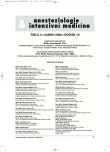Tri-level pulmonary ventilation (3LV®) – initial clinical experience
Authors:
Török Pavol; Šalantay Ján; Čandík Peter; Drbjáková Eva; Saladiak Stanislav; Göryová Jana; Popaďák Ján; Lakatoš Ivan
Authors‘ workplace:
OAIM, Vranovská nemocnica n. o., Vranov nad Topľou, Slovenská republika
Published in:
Anest. intenziv. Med., 19, 2008, č. 2, s. 105-109
Category:
Intensive Care Medicine - Original Paper
Overview
Objective:
To test whether in cases of considerably non-homogenous gas distribution in acute pathological lung conditions it is possible to improve gas distribution into slow broncho-alveolar compartments while decreasing the volume load of the fast compartments, and to improve gas exchange in the lungs while sustaining the principles of “non-injurious ventilation“, by using tri-level (3LV) IPPV.
Setting:
Department of Anaesthesiology and Intensive Care Unit.
Materials and methods:
Authors applied 3LV ventilation to a group of 12 patients with non-homogenous lung injury. Tri-level ventilation is defined as a type (modification) of IPPV consisting of background ventilation using the CMV, PCV or PS (ASB) ventilation mode and an added level called “on-background ventilation“ consisting of multiple levels of PEEP: PEEP (constant) and PEEPh (PEEP high) with variable frequency and duration of transition between individual levels of PEEP.
Results:
The study population consisted of 12 patients with severe non-homogenous lung injury/disorder (atypical pneumonia and ARDS/ALI) who failed to achieve successful ventilation in the PCV mode after a recruitment manoeuvre (PaO₂/FiO₂ = 5–6). After the application of 3LV with respiratory rate of fPCV = 26 ± 4 b . min⁻¹ and PEEPh with frequency of fpeeph = 7 ± 2 b . min⁻¹ reaching minute ventilation (MV) of 12 ± 4 b . min⁻¹ , a considerable improvement in gas exchange was observed within 1–4 hours. Pulmonary shunt decreased from 50 ± 5% to approx. 30 ± 5%. Elimination of CO₂ improved from 7.8 ± 0.5 kPa to less than 6.0 ± 0.3 kPa and PaO₂ increased from 5.4 ± 0.4 kPa to 7.5 ± 1.2 kPa while FiO₂ could be reduced to 0.8–0.4. Alveolar recruitment due to PEEP of 1.2 ± 0.4 kPa which was manifested by an increase in static compliance Cst from 0.18 ± 0.02 l/kPa to 0.3 ± 0.02 l/kPa and later on 0.38 ± 0.05 l/kPa helped to improve gas exchange. Airway resistance (Raw) decreased by more than 30%. The improved aeration of the lungs is considered to be a manifestation of improved gas distribution to the areas with a long time constant. Patients were weaned to pressure support ventilation in 5 ± 1 and later successfully weaned off the ventilator and transferred to a standard ward.
Conclusions:
The clinical results support the mathematical and physical simulation results of ventilation using 3LV. The authors conclude that 3LV improved pulmonary gas exchange compared to PCV in 2–4 hours. Tri-level ventilation could be a promising ventilatory mode for the lungs affected by a diffuse non-homogenous pathological process.
Keywords:
IPPV – tri-level IPPV – ARDS – ALI
Sources
1. Török, P. Teória a matematický model viachladinovej umelej ventilácie pľúc. Anest. intenziv. Med., 2008, 19, 2, s. 96–103.
2. Chirana, s. r. o., Stará Turá Návod na obsluhu servoventilátora Chirolog SV ALFA+C. 2006.
3. Török, P., Májek, M., Kolník, J. Je časová konštanta Tau (τ) pri umelej ventilácii pľúc konštantou? Teoretický a fyzikálny model. Anest. neodklad. Péče, 2001, 12, s. 291–297.
4. Gattinoni, L. et al. Lung structure and function in different stages of severe ARDS. J. Amer. Med. Assoc., 1994, 271, p.1772–1779.
5. Török, P. Multilevel ventilation. In Zborník z konferencie Ruskej akadémie vied – Akútne zlyhanie pľúc. Piešťany-Moskva 30. 9.–3. 10. 2006, 187 s.
6. Oczenski, W. et al. Breathing and mechanical support. Blackwell Science : Vienna 1997, s. 236.
Labels
Anaesthesiology, Resuscitation and Inten Intensive Care MedicineArticle was published in
Anaesthesiology and Intensive Care Medicine

2008 Issue 2
Most read in this issue
- Epidemiology of invasive candidiasis and candidemia – a persistent problem
- LMA-ProSeal™ laryngeal mask is a safe option for securing the airways for laparoscopic cholecystectomy
- Tri-level pulmonary ventilation (3LV®) – initial clinical experience
- Dexmedetomidine-ketamine intravenous sedation during local anaesthesia
